

Gunnera, also galled giant rhubarb, is a plant with gigantic leaves.
Key Gunnera facts
Name – Gunnera manicata
Family – Gunneraceae
Type – perennial
Height – 8 feet (2.5 m)
Exposure – full sun
Soil: moist – Foliage: deciduous in cold areas – Flowering: end of spring → fall
Caring for it is easy and it is guaranteed to produce a great decorative impact!
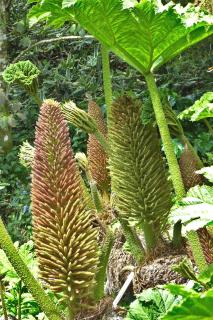 In spring. Choose a very moist place, preferably near a pond or body of water.
In spring. Choose a very moist place, preferably near a pond or body of water.
Propagating Gunnera is performed through crown division in spring, chopping the rhizomes off.
Sowing Gunnera takes place in spring, in nursery pots kept moist until germination has occurred.
Rather hardy, Gunnera does suffer from freezing if temperatures drop below 14°F (-10°C) (or even a bit warmer if it happens over an extended time period). It helps to winterize the plant properly.
Leaves die off when temperatures drop below 32°F (0°C). Roots will survive even colder temperatures, but they must be well protected.
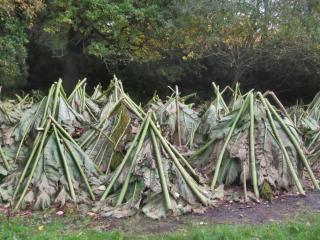 Remove all leaves in fall, snipping them as short as possible.
Remove all leaves in fall, snipping them as short as possible.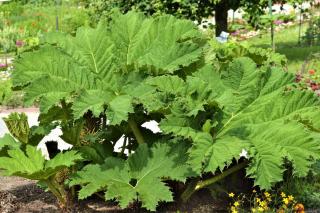 In pots, it’s crucial to water a lot. The soil must stay moist at all times. If ever the soil clump dries out, the plant will have a hard time recovering during the season.
In pots, it’s crucial to water a lot. The soil must stay moist at all times. If ever the soil clump dries out, the plant will have a hard time recovering during the season.
In winter, only water once a month, a little bit, just enough to get the soil a bit moist again.
When planted in the ground, you’ll have to water whenever heat waves hit and during droughts. In time, though, the plant grows deeper roots and you won’t have to water as much.
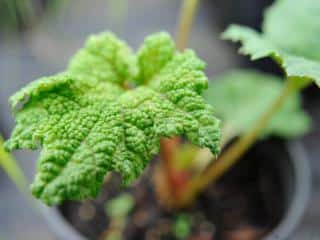 Growing Gunnera in pots is possible if the following is taken into consideration.
Growing Gunnera in pots is possible if the following is taken into consideration.
Roots must be always moist but should not wallow in water or they will rot.
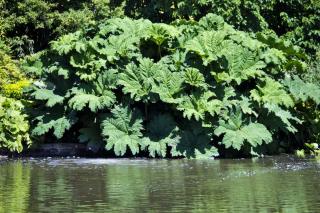 Native to South America, from Brazil, this perennial plant family counts 45 different species, all of them spectacular.
Native to South America, from Brazil, this perennial plant family counts 45 different species, all of them spectacular.
Their leaves are gigantic, and their blooms are too: their flower-studded panicles can be over 5 feet (1.5 meters) tall!
There are no particular requirements to meet when growing them, except for protecting them from the cold in winter and placing them near waterlogged areas.
 Although Gunnera is often called giant rhubarb, don’t presume anything: leaves and stems of gunnera are not edible, unlike those of common rhubarb.
Although Gunnera is often called giant rhubarb, don’t presume anything: leaves and stems of gunnera are not edible, unlike those of common rhubarb.
In fall, use the leaves you have just cut off to protect the stump from the winter cold.
My leaves are turning a little brown on the ends and I don’t know why I keep it watered all the time I even got it sitting in charcoal